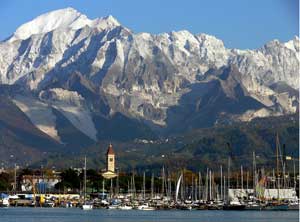Massa
 Massa is a town in the northern part of Tuscany, it belongs to the province of Massa–Carrara as its administrative centre. A population of approximately 69,000 inhabitants is distributed in five boroughs.
Massa is a town in the northern part of Tuscany, it belongs to the province of Massa–Carrara as its administrative centre. A population of approximately 69,000 inhabitants is distributed in five boroughs.
The town is situated in a beautiful area where sea and land join together in a unique landscape so it is no wonder it is an attractive touristic destination. It is located 5 km far from the Ligurian sea.
The town's area, called Apuan Industrial Zone is an important zone for industrial and craft activies where more than 7,000 people work. Massa and its twin town Carrara are worldwide famous for the extraction of marble.
From 15th to 19th century Massa was the capital of the indipendent Principate (later it become Duchy) of Massa and Carrara rouled by the Malaspina family. In 1829 the town was controlled by the Austrian branch of the d'Este family. Thirty years later, during the process of the unification of Italy, it joined the Kingdom of Sardinia.
The town of Massa is characterized by small, narrow, irregular streets and it is full of monuments. In fact, the sights worth seeing in Massa are: The Malaspina Castle (seat of permanent expo of archeological finds), the Renaissance Ducal Palace on Piazza Aranci, and the Cathedral. A different sight to visit could be the botanical garden of the Apuan Alps (in Pian della Foiba)
The highways touching the provinces of Massa and Carrara are the A12, called 'Azzurra' and linking the two towns (that's to say Massa and Carrara) with Livorno and Genoa, and the A15 highway which, passing by Lunigiana valley, link the entire province to A1 and A12. While there are two train lines, the Roma–Pisa–Genova high–speed one and the Aulla–Lucca regional line.
This area has also a good net of road communication linking Italy with France and the centre of Italy with the zone of Pianura Padana.


 Italian
Italian Dutch
Dutch English
English German
German